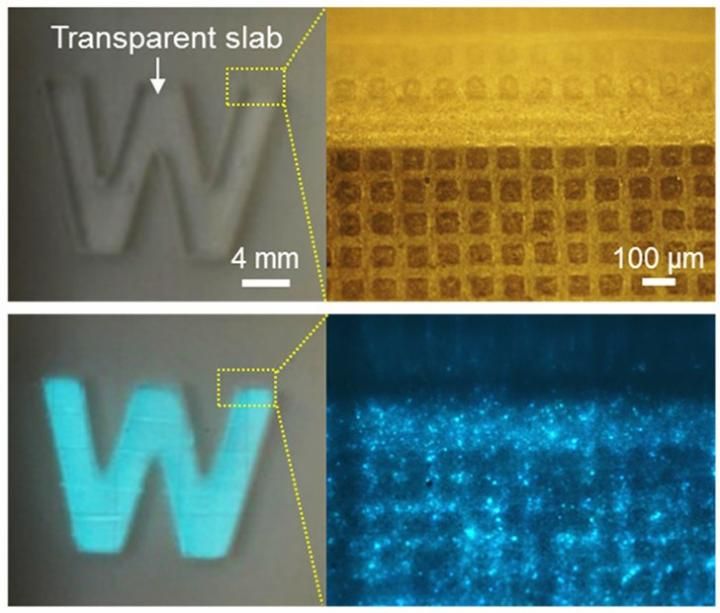Jellyfish-inspired electronic skin glows when it gets hurt
Electronic-skin technologies for prosthetics and robots can detect the slightest touch or breeze. But oddly, the sensors that make this possible do not respond effectively to a harmful blow. Now researchers report the development of a jellyfish-inspired electronic skin that glows when the pressure against it is high enough to potentially cause an injury.

An electronic skin glows when a transparent 'W' is pressed onto it, and a voltage is applied (bottom).
The American Chemical Society
An electronic skin that can mimic the full range of biological skin's sensitivity has great potential to transform prosthetics and robotics. Current technologies are very sensitive, but only within a narrow range of weak pressures. Under high pressures that could cause damage, the electronic skins' sensitivity fades. To address this shortcoming, Bin Hu and colleagues at the Huazhong University of Science and Technology turned to the Atolla jellyfish for inspiration. This bioluminescent, deep-sea creature can feel changes in environmental pressure and flashes dramatically when it senses danger.
Building on the idea of a visual warning in response to a physical threat, the researchers combined electric and optical systems in a novel electronic skin to detect both slight and high-force pressures. They embedded two layers of stretchy, poly-dimethysiloxane, or PDMS, film with silver nanowires. These layers produce an electrical signal in response to slight pressures, such as those created by a breeze or contact with a leaf. Sandwiched in between the silver nanowire electrodes is a PDMS layer embedded with phosphors. This layer kicks in and glows with growing intensity as the physical force increases. The researchers say this approach more closely copies the wide range of pressures the human skin can feel.
Original publication
Most read news
Original publication
Yanli Zhang, Yunsheng Fang, Jia Li, Qihao Zhou, Yongjun Xiao, Kui Zhang, Beibei Luo, Jun Zhou, and Bin Hu; "Dual-Mode Electronic Skin with Integrated Tactile Sensing and Visualized Injury Warning"; ACS Applied Materials & Interfaces; 2017
Topics
Organizations
Other news from the department science
These products might interest you

Hose pressure transducer by HiTec Zang
Contactless pressure measurement for sterile applications
Easy-to-install tubing pressure sensors for diameters from 4.8-19.1 mm

FireSting-PRO by PyroScience
New fiber optic measuring device: Precise measurements even in the smallest volumes
Measure pH, oxygen and temperature even under sterile conditions

Get the life science industry in your inbox
By submitting this form you agree that LUMITOS AG will send you the newsletter(s) selected above by email. Your data will not be passed on to third parties. Your data will be stored and processed in accordance with our data protection regulations. LUMITOS may contact you by email for the purpose of advertising or market and opinion surveys. You can revoke your consent at any time without giving reasons to LUMITOS AG, Ernst-Augustin-Str. 2, 12489 Berlin, Germany or by e-mail at revoke@lumitos.com with effect for the future. In addition, each email contains a link to unsubscribe from the corresponding newsletter.
Most read news
More news from our other portals
Last viewed contents

Diamond dust shines bright in Magnetic Resonance Imaging - Potential alternative to widely used contrast agent gadolinium

New Partnership of CELLphenomics and Kyan Therapeutics - This partnership aims to offer an efficient approach to expedite drug development process in the biopharmaceutical industry






















































